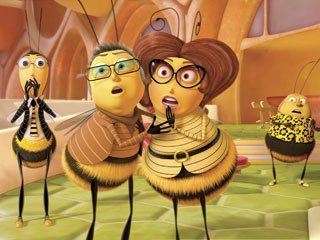Joe Strike gives readers a taste of how DreamWorks Animation worked with Jerry Seinfeld to bring the comedian's vision of an insect society to life in Bee Movie.

The park and its adjoining West Side neighborhood is Jerry Seinfeld's home turf and the setting for Bee Movie. All images & © 2007 DreamWorks Animation LLC. All Rights Reserved.
It all started with a pun. And Steven Spielberg.
At least, that's what the production notes say by way of explaining the genesis of Jerry Seinfeld's Bee Movie. According to said notes, Jerry was over at Steven's beach house in the Hamptons for dinner (there's no mention as to whether Jerry bought some Entenmann's cake along for dessert) when the comic joked about making a film starring insects with the aforementioned title. Steven reached for the phone and called his DreamWorks partner Jeffrey Katzenberg (who for more than a decade had been trying to talk Jerry into doing an animated feature); the next morning, Bee Movie was on DreamWorks' development slate.
Now, four years later, Bee Movie -- and its cartoon version of Seinfeld's Upper West Side Manhattan neighborhood -- is on the multiplex screens. Bridging that gap between New York City and DreamWorks' Glendale campus at first took a lot of traveling -- until technology stepped in to lend a hand.

Co-director Simon J. Smith scoured the park and the West Side to shoot reference pictures for the design staff. His goal was to achieve "stylistic realism."
"When we started out, Jerry had been spending a week a month in L.A. working on the film," Katzenberg explained to a preview audience at New York's Museum of Modern Art this past June. Then the company installed its ultra-high-end, "Star Trek-ian" teleconferencing system HP Halo in Seinfeld's New York office, allowing face-to-face communication and touchscreen interactivity between coasts as if the North American continent were not in the way. "It enabled Jerry to come to work every day, for eight hours a day," Katzenberg added. "It's the only reason the movie got made, with Jerry's life and family here in New York."
Seinfeld's sense of humor is rooted in the city as well, with the comic declaring New York "the Tigris and Euphrates of comedy. I seriously believe comedy, in the American idiom, was invented in the Lower East Side [then an immigrant neighborhood] in the 20th century by the Marx Brothers and all the vaudevillians." DreamWorks Animation also seems to be fond of New York humor, with Bee Movie the studio's third film (after Antz and Madagascar) featuring a Central Park setting. The park and its adjoining West Side neighborhood is Seinfeld's home turf; it was important for the filmmakers to get it right -- not just to please their star, but to give Bee Movie a realistic physical starting point out of which their fantasy version of Manhattan could grow.
After enduring a crash course in Animation 101 with Katzenberg, Seinfeld was ready to take on Bee Movie: "I pretended I knew what I was doing," Seinfeld admits. "I didn't know I would get that interested in an animation studio." As for the physical shtick, Seinfeld offers, "I thought of all these visual scenes that I never had a chance to express before -- a bee on a tennis ball or on an engine."
For co-director (with Steve Hickner) Simon J. Smith, that process began with scouring the neighborhood and the park itself to shoot reference pictures for the film's designers and conceptual artists. Smith's goal for the film's look was "a word we stumbled across in one of our meetings: 'stylism,' or stylistic realism. It's sort of middle ground between Beowulf or even Shrek, which have realistic textures, and Madagascar, which is very cartoony."
While actual textures are often imported into CGI films, "there are no photographic textures in Bee Movie," Smith boasts. "Everything was drawn and designed by us -- bark, wood grain, concrete, bricks -- before it was textured onto objects."
It is less than a month until the film's premiere, but visual effects supervisor Doug Cooper is still busy, tweaking the "color space" for each of the film's iterations -- film, digital cinema, DVD and broadcast -- to make sure they are all identical to the viewer's eye. Nonetheless, he takes time out to further expand on Smith's definition.

The hives were inspired by the soft, organic shapes of blown glass. Everything in the hive world was based on curves, with no straight or parallel lines.
"There are different ways to stylize. In Shark Tale, for example, the stripes on the fish were inspired by skateboard designs. We always try to find different media for inspiration that's not animation. In Bee Movie, the hives were inspired by the soft, organic shapes of blown glass. Everything in the hive world was based on curves; there are no straight or parallel lines there."
Achieving that look called for new tools and methods. Software called "GTree" was developed to forest Central Park. "We'd start with models from the art department, with the form exactly as we wanted it, with simple graphic shapes that resembled cotton candy. GTree filled out those shapes with branches and leaves growing in realistic patterns. When you see one of them, it has a really neat design, but it looks like it grew into that shape naturally.

Vfx Supervisor Doug Cooper and his team went out on some pretty long limbs stylistically early in production, but pulled back when they realized they'd gone too far.
"We went out on some pretty long limbs early in production," Cooper adds, evidently unaware of his pun. "Is our world so stylized we don't need stems -- can the leaves just float around the plant? It looked neat, but we realized we went too far and pulled back. We went for a level of graphic stylization and organization, almost like a perfected version of nature."
The contrast between the bees' world and the human universe is Bee Movie's underlying visual theme. In contrast to the hive's smooth curves and warm colors, the foliage in Central Park is bright and vibrant, with blues, greens, yellows and pinks predominating. Those outdoor colors flood the screen during Seinfeld's bee character's first flight outside the hive, with the camera following him high in the air and down to the park's flowers. It's a sequence that Smith is "really proud of -- a lot of people have told us how wonderful that was."
The difference is even greater between the park and the city just beyond, where colors are cool, subdued, and as Cooper explains "everything is straight lines, right angles and ten times taller than reality." It's here that "Barry B. Benson," voiced by Seinfeld, meets and begins his unusual friendship with Vanessa, a human roughly 60 times his size. Composing shots that kept the film's lead characters in frame together called for some fancy footwork and a few computer cheats along the way.

The film highlights the contrast between the park (left) and the human world. Inside the park, the colors are bright and vibrant, while just beyond the park's borders the city is cool, subdued and made of straight lines.
"We found out early on that we needed to physically change Barry's size just to see him in the human world, and sell the emotional impact of his relationship with Vanessa," says Cooper. "We did tests to figure out how far to push it and built technology to achieve it, without giving it away to the audience that we were cheating.
"In a test scene, Barry's on a cup in the foreground and she's in the middle of the room. It's a nice two-shot with Barry an inch away from camera, but when he gets up and flies across the room, he disappears; from the camera perspective, he's so small on the other side you can't see him. You can't tell a story where the main character is invisible."
"We scaled him up as he flew away. The perspective would make him smaller, but he wouldn't get as small as fast. By the time he landed in that shot, he was three inches tall; then, when we cut to a close-up, he was back to his normal one-inch size. The audience won't feel the cheats at all, but they'll be able to see him when they need to."

Early on, the vfx team had to manipulate Barry's size in the human world, both to keep him visible and to sell the emotional impact of his relationship with Vanessa.
CGI animation is still a relatively youthful medium, with every film presenting new challenges to its creators. Bee Movie is no exception, from rendering the extensive translucency of the bees' hive world to capturing honey's viscous, slow-moving quality. Cooper's biggest accomplishment, however, may have been creating wing blur for thousands of bees in the film's most complex shots. "The last time we dealt with an issue like this was the fairy godmother in Shrek 2. We came up with an effective, believable look based on a realistic simulation of wings beating 100 times a second. It looked great, but it took a huge amount of computing power and was really expensive."

Art director and character designer Christophe Lautrette says his biggest challenge was trying to understand what Seinfeld had in mind and incorporating it into the director's vision.
The solution involved creating a "dry brush" look (named for the 2D process of streaking a cel's wet paint with a dry brush to create a speed blur) via particle animation. "Our proprietary rendering can deal with millions of particles at a time. It's much more efficient than intense volume rendering [used for the fairy godmother's wings], and allowed us to create a sophisticated look that fit in with the movie's stylism."
The finished film is a sophisticated combination of DreamWorks' art and Seinfeld's stand-up sensibilities, with the comic's offbeat observational humor woven into a decidedly unusual take on the traditional "follow your dreams" tale. Art director and character designer Christophe Lautrette says his biggest challenge in making the film was "working with Jerry, both in a good and a not-bad way, trying to understand what he had in mind and incorporating it into the director's vision. Among all my movies, I never had someone so involved in the visuals, the gags of the movie and its characters. We had a lot of close contact between the directors, Jerry himself, Doug and the producer [Christina Steinberg]. Usually it's a big bureaucracy where you stay in your place. But we were a tight crew. You can feel it in the movie. It doesn't feel like it was written on paper -- it feels like it was written at the dinner table with some booze around."
If Bee Movie is a Shrek-sized hit, will Barry B. Benson return for a sequel or three? Seinfeld shrugs off the question. "I never make plans. The only thing I know is I'll be a stand-up comedian forever -- I think that's what I'm meant to do."
Joe Strike is a regular contributor to AWN. His animation articles also appear in the NY Daily News and the New York Press.







